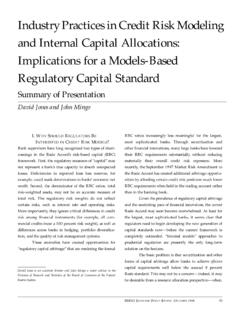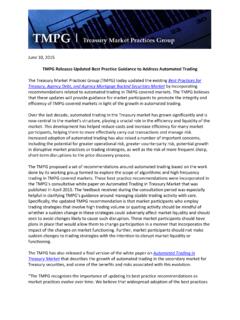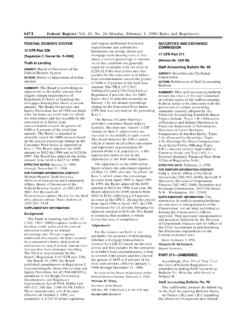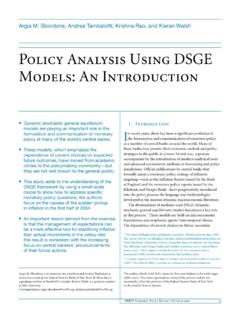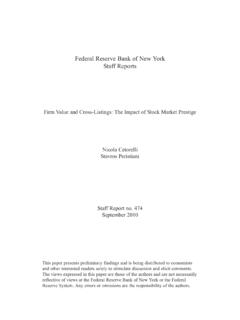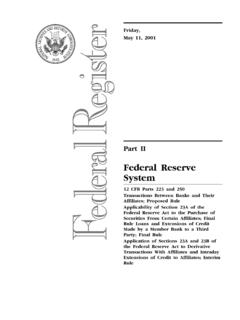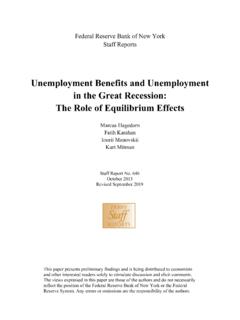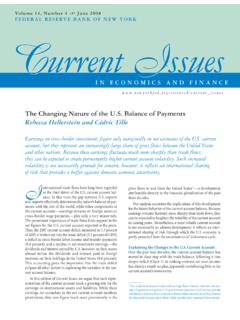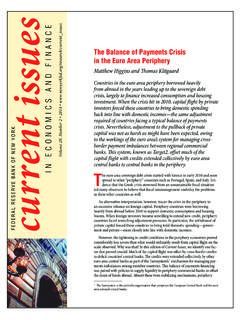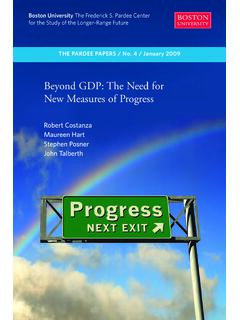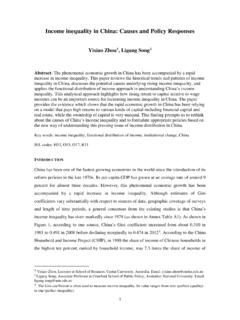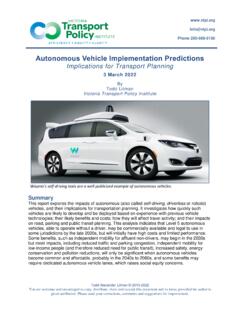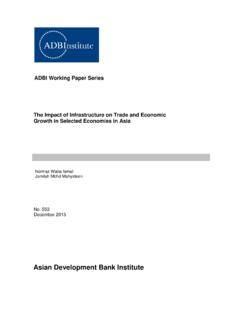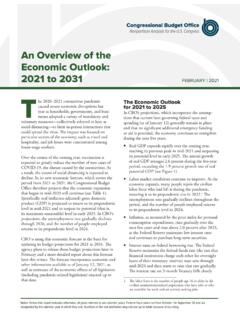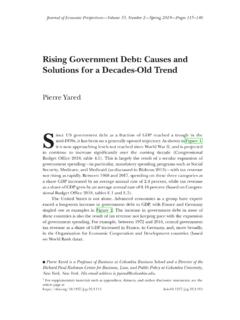Transcription of Exchange Rates and Foreign Direct Investment
1 Exchange Rates and Foreign Direct Investment Written for the Princeton Encyclopedia of the World Economy (Princeton University Press) By Linda S. Goldberg1 Vice President, federal reserve bank of New york Foreign Direct Investment (FDI) is an international flow of capital that provides a parent company or multinational organization with control over Foreign affiliates. By 2005, inflows of FDI around the world rose to $916 billion, with more than half of these flows received by businesses within developing One of the many influences on FDI activity is the behavior of Exchange Rates . Exchange Rates , defined as the domestic currency price of a Foreign currency, matter both in terms of their levels and their volatility. Exchange Rates can influence both the total amount of Foreign Direct Investment that takes place and the allocation of this Investment spending across a range of countries.
2 When a currency depreciates, meaning that its value declines relative to the value of another currency, this Exchange rate movement has two potential implications for FDI. First, it reduces that country s wages and production costs relative to those of its Foreign counterparts. All else equal, the country experiencing real currency depreciation has enhanced "locational advantage" or attractiveness as a location for receiving productive capacity investments. By this 1 federal reserve bank of New york and NBER. The views expressed in this paper are those of the individual author and do not necessarily reflect the position of the federal reserve bank of New york or the federal reserve System. Address correspondences to Linda S. Goldberg, federal reserve bank of NY, Research Department, 33 Liberty St, New york , 10045.
3 Email: 2 2006 World Investment Report (United Nations). relative wage channel, the Exchange rate depreciation improves the overall rate of return to foreigners contemplating an overseas Investment project in this country. The Exchange rate level effects on FDI through this channel rely, on a number of basic considerations. First, the Exchange rate movement needs to be associated with a change in the relative production costs across countries, and thus should not be accompanied by an offsetting increase in the wages and production costs in the destination market for Investment capital. Second, the importance of the relative wage channel may be diminished if the Exchange rate movements are anticipated. Anticipated Exchange rate moves may be reflected in a higher cost of financing the Investment project, since interest rate parity conditions equalize risk-adjusted expected Rates of returns across countries.
4 By this argument, stronger FDI implications from Exchange rate movements arise when these are unanticipated and not otherwise reflected in the expected costs of project finance for the FDI. Some experts on FDI implications of Exchange rate changes dismiss the empirical relevance of the interest-parity type of caveat. Instead, it is argued that there are imperfect capital market considerations, leading the rate of return on Investment projects to depend on the structure of capital markets across countries. For example, Froot and Stein (1991) argue that capital markets are imperfect and lenders do not have perfect information about the results of their overseas investments. In this scenario, multinational companies, which borrow or raise capital internationally to pay for their overseas projects, will need to provide their lenders some extra compensation to cover the relatively high costs of monitoring their investments abroad.
5 Multinationals would prefer to finance these projects out of internal capital if this were an option, since internal capital is increasing in the parent company s wealth. Consider what occurs when Exchange Rates move. A depreciation of the destination market currency raises the relative wealth of source country agents and can raise multinational acquisitions of certain destination market assets. To the extent that source country agents hold more of their wealth in own currency-denominated form, a depreciation of the destination currency increases the relative wealth position of source country investors, lowering their relative cost of capital. This allows the investors to bid more aggressively for assets abroad. Empirical support for this channel is provided by Klein and Rosengren (1994), who show that the importance of this relative wealth channel exceeded the importance of the relative wage channel in explaining FDI inflows to the United States during the period from 1979 through 1991.
6 Blonigen (1997) makes a firm-specific asset argument to support a role for Exchange Rates movements in influencing FDI. Suppose that Foreign and domestic firms have equal opportunity to purchase firm-specific assets in the domestic market, but different opportunities to generate returns on these assets in Foreign markets. In this case, currency movements may affect relative valuations of different assets. While domestic and Foreign firms pay in the same currency, the firm-specific assets may generate returns in different currencies. The relative level of Foreign firm acquisitions of these assets may be affected by Exchange rate movements. In the simple stylized example, if a representative Foreign firm and domestic firm bid for a Foreign target firm with firm-specific assets, real Exchange rate depreciations of the Foreign currency can plausibly increase domestic acquisitions of these target firms.
7 Again, this channel predicts that Foreign currency depreciation will lead to enhanced FDI into the Foreign economy. Data on Japanese acquisitions in the United States support the hypothesis that real dollar depreciations make Japanese acquisitions more likely in industries with firm-specific assets. In addition to these arguments supporting the effects of levels of Exchange Rates , volatility of Exchange Rates also matters for FDI activity. Theoretical arguments for volatility effects are broadly divided into production flexibility arguments and risk aversion arguments. To understand the production flexibility arguments, consider the implications of having a production structure whereby producers need to commit Investment capital to domestic and Foreign capacity before they know the exact production costs and exact amounts of goods to be ordered from them in the future.
8 When Exchange Rates and demand conditions are realized, the producer commits to actual levels of employment and the location of production. As Aizenman (1992) nicely demonstrated, the extent to which Exchange rate variability influences Foreign Investment hinges on the sunk costs in capacity ( the extent of Investment irreversibilities), on the competitive structure of the industry, and overall on the convexity of the profit function in prices. In the production flexibility arguments, the important presumption is that producers can adjust their use of a variable factor following the realization of a stochastic input into profits. Without this variable factor, under a productive structure with fixed instead of variable factors, the potentially desirable effects on profits of price variability are diminished.
9 By the production flexibility arguments, more volatility is associated with more FDI ex ante, and more potential for excess capacity and production shifting ex post, after Exchange Rates are observed. An alternative approach linking Exchange -rate variability and Investment relies on risk aversion arguments. The logic is that investors require compensation for risks that Exchange rate movements introduce additional risk into the returns on Investment . Higher Exchange -rate variability lowers the certainty equivalent expected Exchange -rate level, as in Cushman (1985, 1988). Since certainty equivalent levels are used in the expected profit functions of firms that make Investment decisions today in order to realize profits in future periods. If Exchange Rates are highly volatile, the expected values of Investment projects are reduced, and FDI is reduced accordingly.
10 These two arguments, based on production flexibility versus risk aversion , provide different directional predictions of Exchange rate volatility implications for FDI. The argument that producers engage in international Investment diversification in order to achieve ex post production flexibility and higher profits in response to shocks is relevant to the extent that ex post production flexibility is possible within the window of time before the realization of the shocks. This suggests that the production flexibility argument is less likely to pertain to short term volatility in Exchange Rates than to realignments over longer intervals. When considering the existence and form of real effects of Exchange rate variability, a clear distinction must be made between short term Exchange rate volatility and longer term misalignments of Exchange Rates .
